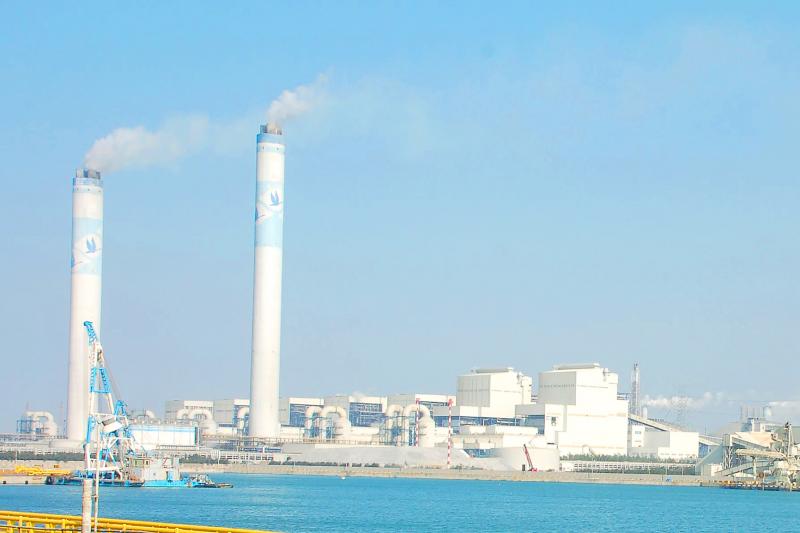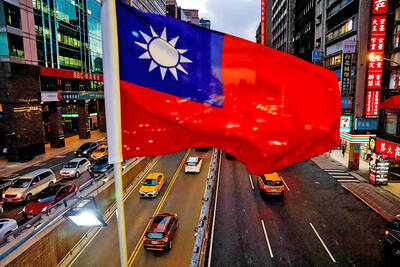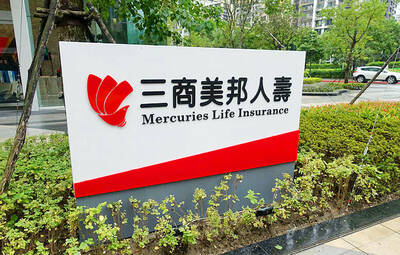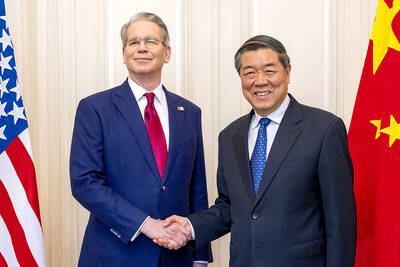Formosa Plastics Corp (台灣塑膠), the flagship entity of Formosa Plastics Group (台塑集團), yesterday said that it would build a new manufacturing site in Texas at a cost of US$207 million.
When completed, the plant would have an annual capacity of 100,000 tonnes of alpha olefins, which are used to make high-density polyethylene (HDPE), among other products, the company said.
About 63,000 tonnes would be used by Formosa Plastics, while the remaining 37,000 tonnes would be sold on the international market, it said.

Photo: CNA
The projected completion date of the plant is October 2025, and mass production is scheduled for December that year after a trial run, the company said.
One of the company’s goals in building the plant in Texas is to secure raw material supply for the production of HDPE, it said, adding that alpha olefins are in high demand worldwide.
Citing a recent report by market information advisory firm IHS Markit, Formosa Plastics said that demand for alpha olefins in North America is expected to hit 915,000 tonnes in 2025, but supply would be only 878,000 tonnes.
The new Texas investment is to be funded by a loan of about US$138 million and capital injection of US$70 million in its fully owned US-based subsidiary Formosa Industrial Corp.
The group has production sites in Texas and Louisiana, where its four major units — Formosa Plastics, Nan Ya Plastics Corp (南亞塑膠), Formosa Chemicals & Fibre Corp (台灣化學纖維) and Formosa Petrochemical Corp (台塑石化) — manufacture petrochemical products such as HDPE, low-density polyethylene (LDPE), ethylene, propylene, polypropylene and ethylene glycol (EG).
The four units on Friday reported mixed revenue results for last month amid China’s anti-epidemic measures, the Russia-Ukraine war and rising inflationary pressure around the world, according to their regulatory filings.
Formosa Chemicals, which manufactures aromatics and styrenics, saw revenue edge up 0.1 percent monthly and 10.2 percent annually to NT$36.42 billion (US$1.23 billion), as price hikes in response to rising crude oil costs offset the impact of lower sales volume.
The other three companies all saw sequential revenue declines, with Nan Ya Plastics registering the biggest drop of 19.7 percent to NT$29.7 billion, as China’s harsh lockdown measures, the Russia-Ukraine war, planned EG production cuts, and changes in consumption caused by inflation affected sales volume and prices.
Compared with April last year, revenue decreased 14.9 percent, said the producer of electronic materials, polyester products, chemical products and plastic products, among others.
Formosa Plastic reported a 5 percent month-on-month decrease in revenue to NT$25.15 billion, but a 3.2 percent increase from a year earlier. The company blamed the monthly revenue drop on declining sales volume of polyethylene and polypropylene.
Formosa Petrochemical, the nation’s only listed oil refiner, reported that revenue dropped 5 percent month-on-month to NT$65.35 billion, as declining sales at its naphtha cracking business offset rising sales at its refining business.
On an annual basis, revenue increased 40.4 percent because of higher product prices this year, the firm said.
In the first four months of the year, Formosa Petrochemical reported the highest annual increase of 41.9 percent in revenue to NT$250.9 billion, ahead of Formosa Plastics’ 13.2 percent increase to NT$96.15 billion, Formosa Chemicals’ 12.5 percent rise to NT$131.82 billion and Nan Ya’s 5.8 percent growth to NT$131.79 billion, companies’ data showed.

France cannot afford to ignore the third credit-rating reduction in less than a year, French Minister of Finance Roland Lescure said. “Three agencies have downgraded us and we can’t ignore this cloud,” he told Franceinfo on Saturday, speaking just hours after S&P lowered his country’s credit rating to “A+” from “AA-” in an unscheduled move. “Fundamentally, it’s an additional cloud to a weather forecast that was already pretty gray. It’s a call for lucidity and responsibility,” he said, adding that this is “a call to be serious.” The credit assessor’s move means France has lost its double-A rating at two of the

AI BOOST: Although Taiwan’s reliance on Chinese rare earth elements is limited, it could face indirect impacts from supply issues and price volatility, an economist said DBS Bank Ltd (星展銀行) has sharply raised its forecast for Taiwan’s economic growth this year to 5.6 percent, citing stronger-than-expected exports and investment linked to artificial intelligence (AI), as it said that the current momentum could peak soon. The acceleration of the global AI race has fueled a surge in Taiwan’s AI-related capital spending and exports of information and communications technology (ICT) products, which have been key drivers of growth this year. “We have revised our GDP forecast for Taiwan upward to 5.6 percent from 4 percent, an upgrade that mainly reflects stronger-than-expected AI-related exports and investment in the third

Mercuries Life Insurance Co (三商美邦人壽) shares surged to a seven-month high this week after local media reported that E.Sun Financial Holding Co (玉山金控) had outbid CTBC Financial Holding Co (中信金控) in the financially strained insurer’s ongoing sale process. Shares of the mid-sized life insurer climbed 5.8 percent this week to NT$6.72, extending a nearly 18 percent rally over the past month, as investors bet on the likelihood of an impending takeover. The final round of bidding closed on Thursday, marking a critical step in the 32-year-old insurer’s search for a buyer after years of struggling to meet capital adequacy requirements. Local media reports

RARE EARTHS: The call between the US Treasury Secretary and his Chinese counterpart came as Washington sought to rally G7 partners in response to China’s export controls China and the US on Saturday agreed to conduct another round of trade negotiations in the coming week, as the world’s two biggest economies seek to avoid another damaging tit-for-tat tariff battle. Beijing last week announced sweeping controls on the critical rare earths industry, prompting US President Donald Trump to threaten 100 percent tariffs on imports from China in retaliation. Trump had also threatened to cancel his expected meeting with Chinese President Xi Jinping (習近平) in South Korea later this month on the sidelines of the APEC summit. In the latest indication of efforts to resolve their dispute, Chinese state media reported that